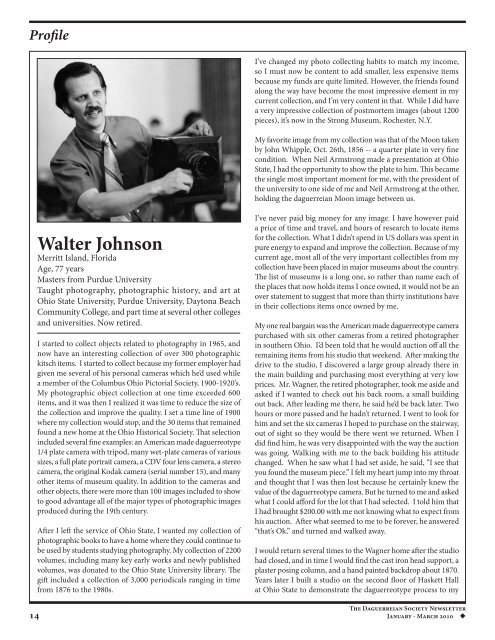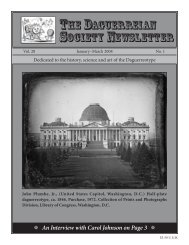THE DAGUERREIAN SOCIETY NEWSLETTER
THE DAGUERREIAN SOCIETY NEWSLETTER
THE DAGUERREIAN SOCIETY NEWSLETTER
You also want an ePaper? Increase the reach of your titles
YUMPU automatically turns print PDFs into web optimized ePapers that Google loves.
Pro�le<br />
14<br />
Walter Johnson<br />
Merritt Island, Florida<br />
Age, 77 years<br />
Masters from Purdue University<br />
Taught photography, photographic history, and art at<br />
Ohio State University, Purdue University, Daytona Beach<br />
Community College, and part time at several other colleges<br />
and universities. Now retired.<br />
I started to collect objects related to photography in 1965, and<br />
now have an interesting collection of over 300 photographic<br />
kitsch items. I started to collect because my former employer had<br />
given me several of his personal cameras which he’d used while<br />
a member of the Columbus Ohio Pictorial Society, 1900-1920’s.<br />
My photographic object collection at one time exceeded 600<br />
items, and it was then I realized it was time to reduce the size of<br />
the collection and improve the quality. I set a time line of 1900<br />
where my collection would stop, and the 30 items that remained<br />
found a new home at the Ohio Historical Society. �at selection<br />
included several �ne examples: an American made daguerreotype<br />
1/4 plate camera with tripod, many wet-plate cameras of various<br />
sizes, a full plate portrait camera, a CDV four lens camera, a stereo<br />
camera, the original Kodak camera (serial number 15), and many<br />
other items of museum quality. In addition to the cameras and<br />
other objects, there were more than 100 images included to show<br />
to good advantage all of the major types of photographic images<br />
produced during the 19th century.<br />
A�er I le� the service of Ohio State, I wanted my collection of<br />
photographic books to have a home where they could continue to<br />
be used by students studying photography. My collection of 2200<br />
volumes, including many key early works and newly published<br />
volumes, was donated to the Ohio State University library. �e<br />
gi� included a collection of 3,000 periodicals ranging in time<br />
from 1876 to the 1980s.<br />
I’ve changed my photo collecting habits to match my income,<br />
so I must now be content to add smaller, less expensive items<br />
because my funds are quite limited. However, the friends found<br />
along the way have become the most impressive element in my<br />
current collection, and I’m very content in that. While I did have<br />
a very impressive collection of postmortem images (about 1200<br />
pieces), it’s now in the Strong Museum, Rochester, N.Y.<br />
My favorite image from my collection was that of the Moon taken<br />
by John Whipple, Oct. 26th, 1856 -- a quarter plate in very �ne<br />
condition. When Neil Armstrong made a presentation at Ohio<br />
State, I had the opportunity to show the plate to him. �is became<br />
the single most important moment for me, with the president of<br />
the university to one side of me and Neil Armstrong at the other,<br />
holding the daguerreian Moon image between us.<br />
I’ve never paid big money for any image. I have however paid<br />
a price of time and travel, and hours of research to locate items<br />
for the collection. What I didn’t spend in US dollars was spent in<br />
pure energy to expand and improve the collection. Because of my<br />
current age, most all of the very important collectibles from my<br />
collection have been placed in major museums about the country.<br />
�e list of museums is a long one, so rather than name each of<br />
the places that now holds items I once owned, it would not be an<br />
over statement to suggest that more than thirty institutions have<br />
in their collections items once owned by me.<br />
My one real bargain was the American made daguerreotype camera<br />
purchased with six other cameras from a retired photographer<br />
in southern Ohio. I’d been told that he would auction o� all the<br />
remaining items from his studio that weekend. A�er making the<br />
drive to the studio, I discovered a large group already there in<br />
the main building and purchasing most everything at very low<br />
prices. Mr. Wagner, the retired photographer, took me aside and<br />
asked if I wanted to check out his back room, a small building<br />
out back. A�er leading me there, he said he’d be back later. Two<br />
hours or more passed and he hadn’t returned. I went to look for<br />
him and set the six cameras I hoped to purchase on the stairway,<br />
out of sight so they would be there went we returned. When I<br />
did �nd him, he was very disappointed with the way the auction<br />
was going. Walking with me to the back building his attitude<br />
changed. When he saw what I had set aside, he said, “I see that<br />
you found the museum piece.” I felt my heart jump into my throat<br />
and thought that I was then lost because he certainly knew the<br />
value of the daguerreotype camera. But he turned to me and asked<br />
what I could a�ord for the lot that I had selected. I told him that<br />
I had brought $200.00 with me not knowing what to expect from<br />
his auction. A�er what seemed to me to be forever, he answered<br />
“that’s Ok,” and turned and walked away.<br />
I would return several times to the Wagner home a�er the studio<br />
had closed, and in time I would �nd the cast iron head support, a<br />
plaster posing column, and a hand painted backdrop about 1870.<br />
Years later I built a studio on the second �oor of Haskett Hall<br />
at Ohio State to demonstrate the daguerreotype process to my<br />
The Daguerreian Society Newsletter<br />
January - March 2010!"




